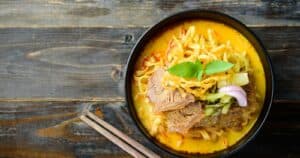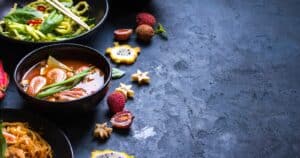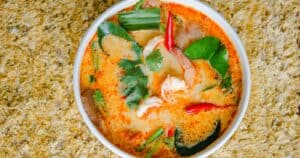Food enthusiasts around the world have likely tried both Thai food and Chinese food at some point. But what exactly is the difference between Thai food and Chinese food? While these two beloved Asian cuisines share some similarities, they each offer unique ingredients, cooking techniques, flavor profiles, and dishes that distinguish them.
This article will highlight the key differences between Thai food and Chinese food to uncover what makes each cuisine special in its own right. Read on to learn all about the spicy, complex flavors of Thai cuisine versus the diverse regional styles of Chinese cooking.
Spice Levels – Bringing on the Heat in Thai Food

One of the biggest differences between Thai food and Chinese food comes down to the level of spiciness. Thai food has a reputation for being very spicy and bold in its flavors.
Thai food spicy level can range significantly depending on the dish, restaurant, and region of Thailand. Northeastern Thai cuisine, in particular, is known for extremely spicy flavors.
Here’s an overview of the Thai food spicy level scale:
- Level 1: Mild Spices – Dishes offer just a touch of heat and are suitable for
spice novices. Examples are coconut-based curries. - Level 2: A Little Spicy – The heat gets turned up a notch but is still manageable for those new to Thai flavors. Dishes like drunken noodles fall in this range.
- Level 3: Spicy – Now we’re getting into the spicy zone, with dishes packing more chili heat. Green curries and stir fries often reach this level.
- Level 4: Very Spicy – For major
spice lovers only! Expect tongue-tingling, sweat-inducing heat. Isan sausages and dipping sauces get fiery. - Level 5: Extremely Spicy – The most intensely spicy Thai food dishes meant to challenge the boldest palates. Products like bird’s eye chilies push the limits.
In contrast, Chinese food is typically milder in terms of spiciness. Chinese cuisine relies more on sauces, aromatics, and stir-frying techniques to build complex flavors instead of just heat. However, there are exceptions.
Sichuan cuisine stands out for its liberal use of chili peppers and Sichuan peppercorns, creating a signature spiciness and numbing effect. Dishes like Kung Pao Chicken and Mapo Tofu certainly bring the heat!
Overall though, those craving seriously fiery food would likely be more satisfied by Thai food over Chinese food in terms of scoville units. But Chinese cuisine offers plenty of subtler flavors to savor.
Cooking Techniques – Woks Blazing in Thai and Chinese Kitchens
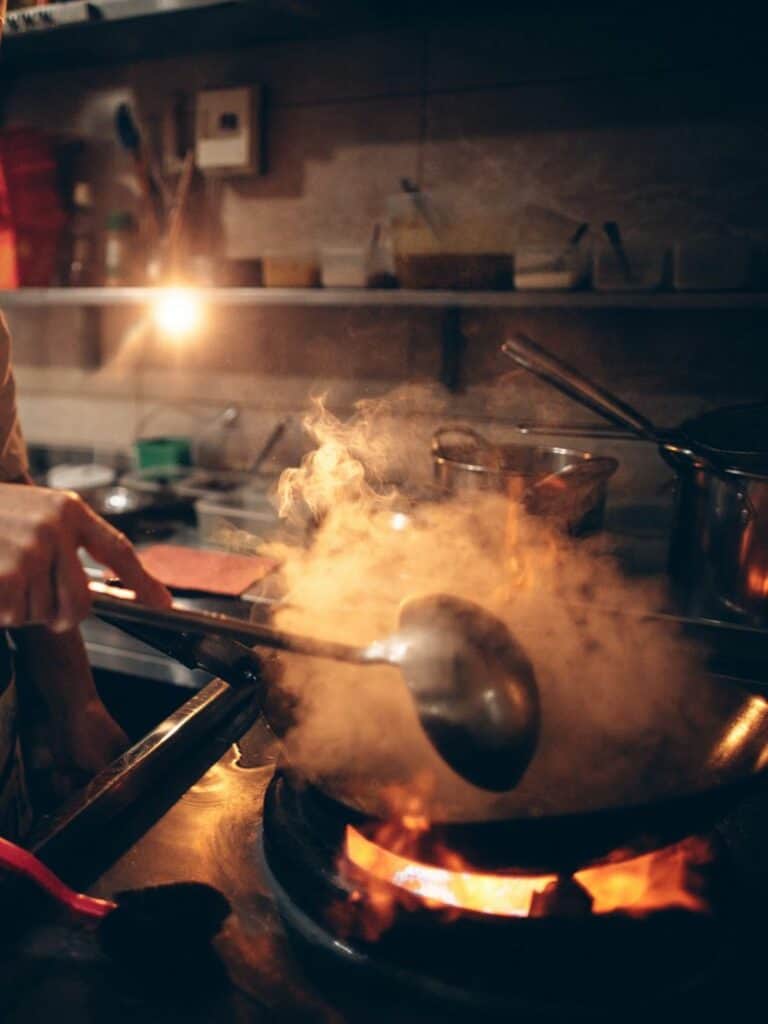
Both Thai food and Chinese food rely heavily on quick cooking techniques like stir-frying using intense heat and woks. However, there are also some signature cooking methods in each cuisine.
Popular Thai food cooking techniques include:
- Stir-frying (pad)
- Grilling (yang) – Grilling meats, seafood, and veggies over an open flame.
- Steaming (neung) – Cooking ingredients in a steamer.
- Deep-frying (tod) – Crisping up meats and veggies by submerging in hot oil.
- Salad Tossing (yum) – Tossing proteins and vegetables in a tangy dressing.
For Chinese food, go-to cooking techniques are:
- Stir-frying – The wok is essential!
- Steaming – Used to prepare dim sum, fish, veggies.
- Deep-frying – Creates crispy textures.
- Red cooking (hong shao) – Braising meat in soy sauce.
- Poaching – Gently simmering items like wontons or egg noodles.
So while Thai food and Chinese food both leverage stir-frying, Thai food has some additional signature methods like grilling and salad tossing. Chinese food takes cues from steaming, red cooking, and poaching.
The diversity of techniques ensures every bite offers new flavors and textures!
Flavor Profiles – Striking a Balance in Thai Cuisine
When it comes to flavors, Thai food puts an emphasis on achieving a harmonious balance between spicy, sour, salty, sweet, and bitter flavors. This balance is key in Thai cooking.
Signature Thai flavor pairings include:
- Chili peppers – Bring the spicy heat.
- Lime juice, tamarind – Lend a sour tang.
- Fish sauce, soy sauce – Provide saltiness.
- Palm sugar, coconut milk – Offer sweetness.
- Bitter melon, eggplant – Contribute slight bitterness.
In a single Thai dish, you’ll often find a mix of these tastes intermingling. The goal is for no single flavor to overpower – instead, they complement one another.
For example, the sweet and salty coconut milk balances out the sour lime juice and fierce chili kick in a green curry. This blend of flavors is a hallmark of Thai cuisine.
In Chinese food, the flavors tend to be more focused on achieving a balance between salty, sweet, sour, and umami tastes. There is less emphasis on spiciness or bitterness.
Chinese food relies on ingredients like soy sauce, oyster sauce, vinegar, and hoisin for salty, sweet, and sour notes. Umami comes from soy paste, fermented black beans, and dried shrimps.
So while Thai food spotlights spicy heat and bitter tones, you’ll find those less pronounced in Chinese food. It comes down to different flavor philosophies.
Signature Dishes
To get a true sense of Thai food versus Chinese food, looking at some signature dishes is key. Here are some classics from each cuisine:
Thai Cuisine Signature Dishes
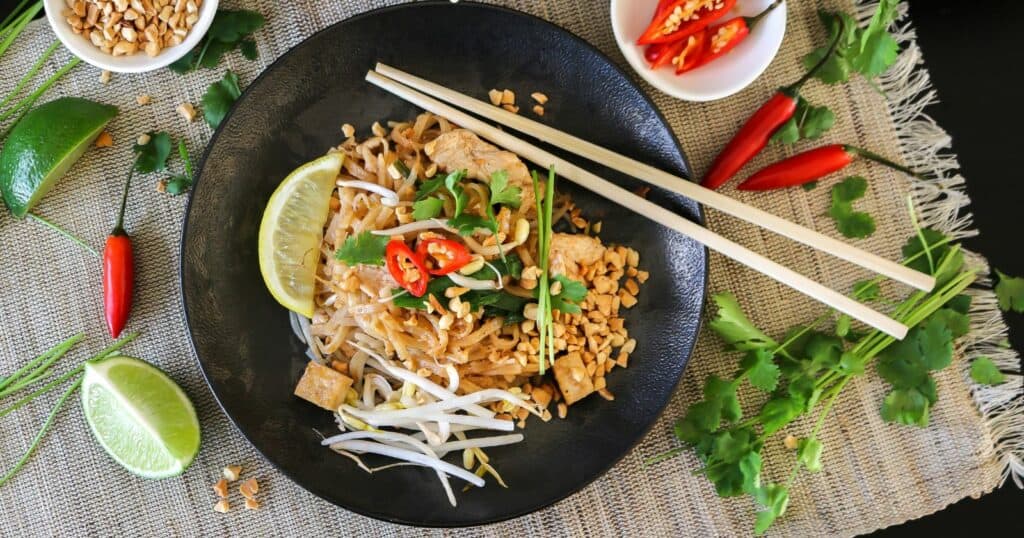
- Pad Thai – Stir-fried rice noodles with egg, peanuts, and proteins like shrimp.
- Tom Yum Soup – A hot and sour broth with lemongrass, chili, and mushrooms.
- Som Tam – A spicy green papaya salad tossed with tomatoes and peanuts.
- Massaman Curry – A mild, coconut curry with potatoes, chicken, and warm spices.
- Khao Soi – Crispy egg noodles topped with a rich coconut curry.
Chinese Cuisine Signature Dishes

- Peking Duck – A roasted duck served with thin pancakes, hoisin sauce, and scallions.
- Dumplings – Filled dough pockets steamed or fried, like shrimp shumai.
- Kung Pao Chicken – Diced chicken wok-fried with vegetables and chili peppers.
- Ma Po Tofu – Soft tofu and ground pork in a fiery chili sauce.
- Congee – A thick rice porridge often served for breakfast.
You can see both cuisines offer an array of classic dishes, from noodle staples like pad Thai and dumplings to spicy stir-fries. The Thai dishes often pack more heat while the Chinese dishes focus on varied textures.
Sauces and Condiments – Fish Sauce, Chili Oil, and More!
The sauces and condiments used in Thai food and Chinese food also differ, customizing flavors in each cuisine.
In Thai food, sauces provide spicy, salty, and sour flavors. Popular condiments include:
- Fish sauce – Salty, umami seasoning made from fermented anchovies.
- Nam pla prik – Spicy fish sauce with chopped chilies.
- Sriracha – Tangy and spicy chili garlic sauce.
- Nam chim – Sweet, sour, and savory dipping sauces.
For Chinese food, staple sauces provide saltiness, sweetness, and depth:
- Soy sauce – Brewed from soybeans, water and wheat.
- Oyster sauce – Made from oyster juices and molasses.
- Hoisin sauce – Sweet, salty sauce with garlic and chilies.
- Chili oil – Infused oil with dried chilies, great for heat.
So you’ll be reaching for the fish sauce and Sriracha to liven up your pad Thai, while Chinese dumplings shine when dipped in soy sauce and chili oil. The sauces complement each cuisine perfectly.
Regional Variations – Diverse Eats Across Thailand and China
One key aspect of both Thai food and Chinese food is that they vary dramatically by region. This regional diversity expands each cuisine’s range of flavors and dishes.
Some examples of regional Thai food include:
- Northern Thai – Influenced by Burma and Laos. Khao Soi is a signature dish.
- Northeastern Thai – Bolder, spicier flavors like papaya salad.
- Southern Thai – Flavors from Malaysia and Indonesia. More seafood.
- Central Thai – Balance of spicy, sour, sweet. Includes pad Thai.
For Chinese food, major regional styles include:
- Cantonese – Light, fresh flavors. Known for dim sum.
- Sichuan – Spicy dishes that use Sichuan peppercorns.
- Hunan – Spicy and sour flavors, stewed and braised meats.
- Shanghainese – Focuses on preserving natural flavors of ingredients.
This incredible regional diversity in both cuisines translates to more variety of dishes to enjoy!
Dining Etiquette – Slurping Noodles and Beyond
While both cuisines use chopsticks and spoons as utensils, there are some differing etiquette rules between Thai and Chinese dining:
- In Thailand, slurping noodles is acceptable and even seen as a compliment! In China, noodles should be slurped more quietly.
- Leaving food on your plate in Thailand is fine, but in China it can imply you didn’t get enough to eat.
- Pointing your chopsticks at others is considered rude in both cultures, but holding chopsticks vertically in rice is a Chinese taboo.
- In Thailand, dishes are shared family style, while in China individuals often have their own plates.
So mind your slurping levels, plate cleaning, and chopstick manners between the two dining experiences!
Snack Time – Street Eats of Thailand and China
Both Thai and Chinese cuisine offer amazing street food snacks:
- Thailand is famous for pad thai, grilled meats, and green papaya salad from street carts.
- Chinese street eats include soups and dumplings, tangy skewers, pigs ears, and stinky tofu.
- Vendors often customize Thai dishes to order. Chinese street food tends to be pre-made.
- Portable and shareable bites rule the street food scene in both cultures.
When hunger strikes, hit the streets in either country for these flavorful, authentic quick eats!
Thai Food vs. Chinese Food: The Final Verdict
While Thai food and Chinese food share similarities like frequent use of noodles, rice, and wok cooking, they have many distinct differences when it comes to spiciness, flavor balance, sauces, and signature dishes.
Thai food brings the chili heat, balances sweet, sour, salty, and bitter flavors, and spotlights dishes like pad Thai and tom yum soup.
Chinese food focuses on subtle flavor layering, draws from regional styles like Cantonese and Sichuan, and offers classics such as dumplings and Peking duck.
At the end of the day, the best way to appreciate the nuances of each cuisine is to dig in! Both Thai food and Chinese food offer amazing culinary journeys for taste explorers everywhere. It’s a win-win when you’re eating delicious Asian food.



